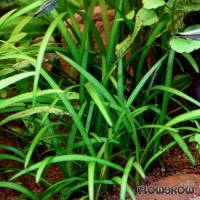



Sagittaria subulata originates from the east of the USA and from South-America, where it grows in fresh well as in brackish water. Especially in estuaries it has been known to form vast meadows. This arrowhead species is a longstanding, very popular aquarium plant cultivated by most of the major aquatic plant nurseries and regularly found in trade. Those plants sold under the name Sagittaria pusilla are said to stay smaller than "normal" S. subulata, however, there is reason to believe that they are not different from true S. subulata. Some nurseries also use the trade name "Sagittaria teres" or "S. terres". True S. teres, however, is a totally different species that probably isn't cultivated under aquarium conditions so far.
S. subulata is very easy in cultivation, only needs moderate light and tolerates rather hard alkaline water. It grows well in aquaria without CO2 injection, even though the addition of CO2 helps growth immensely. A substrate rich in nutrients or water with a high concentration of nitrate, phosphate, potassium, iron and trace elements lead to strongest growth. This plant is especially susceptible to iron deficiencies, which shows in a yellow discolouration of the leaves. Intensive light causes the shoot tips to attain a reddish tint.
When densely planted, the leaves can grow to a length of up to 60 cm. Less dense groups will result in lesser growth of only 5 to 10 cm. S. subulata is a fast grower spreading by runners, and able to form a dense carpet after a short time. Sometimes the plant grows long flower stalks that reach the water surface, where they sprout tiny white flowers. In contrast to other Sagittaria species, the flower stalks don't stand out vertically but float on the water surface. Under very favourable conditions, S. subulata sprouts long-stalked floating leaves with an elliptic leaf blade. The emersed growth habit of S. subulata is very low, the leaf rosettes spread wide and the leaves are often spatulate.
There are several varieties of S. subulata. One of them was sold under the name Sagittaria natans in earlier times. In Central Europe it is a hardy plant and can remain outdoors over the winter. In shallow parts of ponds it forms many flower stalks and floating leaves with reddish-brown spots. On the ends of its runners it forms tiny overwintering bulbs. In the aquarium, this variety forms especially long submersed leaves that turn to a brownish green to reddish brown under lots of light.
Its - at least most of the times - low average height makes S. subulata a good fore- and middleground plant in the aquarium, or a good plant for dense groups. Its grasslike texture can also be used to accentuate other plant species with a different growth habit like Anubias barteri var. nana and Glossostigma elatinoides to add contrast and get a natural look. If you let this arrowhead grow to 60 cm in height you can also use it in the background of your layout to create vertical structures.
<a href="https://www.flowgrow.de/db/aquaticplants/sagittaria-subulata" target="_blank"><img alt="Sagittaria subulata" title="Sagittaria subulata" src="https://www.flowgrow.de/db/widget/aquaticplants/sagittaria-subulata" /></a>
[url=https://www.flowgrow.de/db/aquaticplants/sagittaria-subulata][img]https://www.flowgrow.de/db/widget/aquaticplants/sagittaria-subulata[/img][/url]
[widget=aquaticplants/sagittaria-subulata]Sagittaria subulata[/widget]